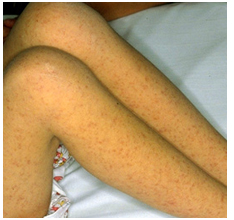Hypochondriacs beware. The Rocky Mountain spotted fever and lyme disease caused by ticks is nothing to take lightly—especially in the dry season when ticks are most prominent, even more so due to global warming.
Rocky Mountain spotted fever, which was first identified in the Rocky Mountains, is caused by the bacteria Rickettsia rickettsii, when an infected tick comes in contact with humans. The ticks affected by the bacteria include the American dog tick, the lone-star tick, and the wood tick, all of which like to live in wooded areas and tall, grassy fields.
Similarly, Lyme disease is named after the place it was discovered in Lyme, Connecticut in 1975. It is caused by a cork-screw like bacterium called Borrelia burgdorferi. The black-legged ticks are usually the ones that spread the disease. Like its progressive corkscrew shaped bacterium, ticks are affected by feeding off small animals with the disease. These animals usually include mice, chipmunks, and other wild rodents. When the infected tick attaches to a person or animal and stays attached long enough (usually more than 36 hours) to take a “blood meal” it has further passed on the infection.

Not the author's legs.
The conditions have similar repercussions. The Rocky Mountain fever, which develops within one week of a person becoming infected by the tick, brings on headaches, tiredness, muscle pain, chills and nausea—then comes the rash. It might begin on the legs or arms and take off from there all over the rest of the body.
Lyme disease affects about 16,000 people in the U.S. as opposed to the 800 victims of the Rocky Mountain spotted fever, but involves the same exhaustion, chills, fever headache, muscle or joint pain, swollen lymph glands as the Rocky Mountain fever. The skin rash that appears can be differentiated from that of the spotted fever in that it looks like Saturn rings around the bite.
The tick with Lyme disease has a two-year lifespan and three stages of growth called the larvae, nymph, and adult stages. In the larvae and nymph stages, the tick is very small ranging to the size of a pin head to a poppy seed. Adult ticks are a tad bigger, are black or reddish and feed on larger mammals such as deer, dogs, and humans, rather than on smaller creatures like in its younger years.
Research on the Rocky Mountain spotted fever is mostly done at the National Institute of Allergy and Infectious Diseases Rocky Mountain Laboratories in Hamilton, Montana. However the ongoing research about Lyme disease greatly overshadows that of the fever, especially at the Lyme Disease Research Center in affiliation with Columbia University. Currently, studies are being performed about the developmental delay in children with the disease.
Without the treatment of the fever from antibiotics and in many cases hospitalization, a patient can develop kidney failure and shock resulting in death. Symptoms of Lyme disease appear after a few weeks up to a few years. Antibiotics taken for about one month are prescribed for the cases that are lucky enough to be diagnosed. More difficult cases and late diagnosis may require longer treatment and combinations of drugs. People with Lyme disease live with arthritis, nervous system problems and heart irregularities if they don’t detect early warning signs.
Experts at the Lyme Disease Research Center are currently taking volunteers with Lyme disease over 18 in research which examines differences between SPECT, or 3D, images of Lyme disease with other disorders. Statistics about both diseases can be found on the website of the National Center for Infectious Diseases.




Comments